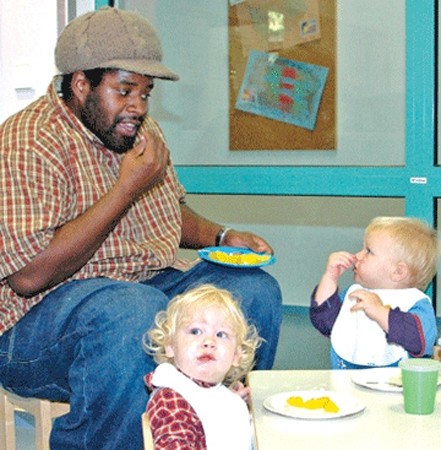WIESBADEN, Germany - Imagine if your baby could let you know when he is hungry or thirsty without doing so by whining or crying. It is possible and it is happening at Department of Defense Child Development Centers as a result of a new program that teaches very young hearing children how to use sign language to communicate their needs.
The Baby Signs Program is for children who do not yet speak or have a vocabulary of only a few words. They learn basic hand signs for everyday words such as "more" and "juice," allowing them to get their message across with less frustration for them and their families.
The program is included in the Army Family Covenant as a means to relieve stress on children, child care staff and families by reducing crying and attachment-related behaviors.
"About two years ago, the Department of Defense said let's support our families; there is so much on their plates right now. How can we help reduce the level of frustration," explained Jan Allison, Installation Management Command-Europe Child Youth and School Services training coordinator.
Accordingly, Allison has led train-the-trainer sessions at the Wiesbaden Army Airfield CDC, with participants becoming certified to conduct training in Baby Signs for their garrison CYSS programs. The goal is for the program to be implemented throughout military child care programs. Plus there are plans for the center here to have a signing class for parents.
Caregivers in the WAAF CDC Infant/Pre-toddler room have been teaching the program for a few months. "We immediately saw results. As caregivers we were amazed at how quickly the pre-toddlers were responding to us," said Theresa Wilt, a lead child and youth program associate at the CDC.
"It started at the table. We taught them the sign for 'more' and we found that they responded immediately primarily because of the immediate gratification," added Wilt.
"We were falling all over ourselves to get them more food."
The use of hand signs has reduced the level of frustration in the classroom. "The children can just walk up and give the sign for what they want, that way we don't have to guess what it is they need," said Wilt. "We have children as young as 12 months old responding."
"The children will give us the sign for 'all done' and then hand us their plate," added Wilt. "It was very rewarding for the caregivers."
Opponents argue that teaching signing to very young children can delay speech, but Wilt said that research indicates that is not the case. "Those who have learned signing score higher on IQ tests."
Baby Signs creators, Dr. Linda Acredolo and Dr. Susan Goodwyn, have conducted two decades of research into teaching signing to hearing babies. The Baby Signs Institute says the research found that 24-month-old children were speaking more like 27- or 28-month- old children and were putting together significantly longer sentences. The research also found that 8-year-olds who had signed as babies scored an average of 12 points higher on IQ tests.
Baby Signs, Inc. officials said signing builds trust between babies and caregivers, strengthens the parent/infant bond, boosts emotional development and builds self-confidence, helps babies learn to talk and reveals and jumpstarts babies' intelligence.
"Signing is a bridge from their world to our world," explained Allison. "The baby can communicate his or her needs, the parent/caregiver can meet those needs and there is less frustration."
"As a parent we are often at a loss as to how to communicate with babies. As a parent I wish I had known about this to use throughout the toddler years," said Wilt. "I would have used it myself."
For more information about Baby Signs, Inc. log on to www.babysigns.com.




Social Sharing